






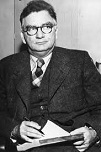

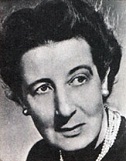
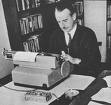











TLW's Mystery Novelist Historyscope |
By T.L. Winslow (TLW), the Historyscoper™ |
© Copyright by T.L. Winslow. All Rights Reserved. |
Original Pub. Date: Aug. 25, 2015. Last Update: Feb. 21, 2018. |

Westerners are not only known as history ignoramuses, but double dumbass history ignoramuses when it comes to mystery novels and mystery novelist history. Since I'm the one-and-only Historyscoper (tm), let me quickly bring you up to speed before you dive into my Master Historyscope.

In Dec. 1833 Portsea, Portsmouth-born Charles John Huffam Dickens (1812-70) pub. his first fictional piece Mr. Minns and His Cousin (A Dinner at Poplar Walk) in Old Monthly Mag., going on to pub. Sketches by Boz (short stories) in Old Monthly Mag. and Morning Chronicle. In 1836 he pub. Posthumous Papers of the Pickwick Club (The Pickwick Papers) (serialized in 1837); begins as lit. commentary for humorous drawings by Robert Seymour at Chapman and Hall, bringing him instant fame and going internat., with 400K copies sold per mo.; Mr. Samuel Pickwick, pres. of the Pickwick Club; happy-go-lucky medical students Bob Sawyer and Ben Allen. In 1837-9 he pub. Oliver Twist; or, The Parish Boy's Progress, with illustrations by George Cruikshank; Noah Claypole, Mr. Brownlow, 4'6" Artful Dodger Jack Dawkins; workhouse boss (constabular beadle) Mr. Bumble ("the law is a ass"), who dishes out oatmeal, and to whom Oliver issues the immortal soundbyte: "Please, sir, I want some more"; dog-kicking Bill Sykes, his mean bulldog Bull's-Eye and his bird Nancy; his boss, Jewish pickpocket gang king Fagin (Gael. "little ardent one") is hanged at the end, which draws such an angry reaction from Londoners that he tones it down in future eds.; Dicken's best friend is Bob Fagin; Oliver is adopted by Mr. Brownlow and ends up well-fed and happy. In 1838-9 he pub. The Life and Adventures of Nicholas Nickleby; young Nicholas must support his mother and sister after his father dies while dealing with Uncle Ralph, who thinks he's a bum because he goes around rescuing victims of improbable cruelty; Wackford Squeers of Dotheboys Hall. In 1840-1 he pub. The Old Curiosity Shop; Little Nell and her grandfather, whose London curiosity shop is seized for debt by repulsive dwarf Quilp, causing them to flee and wander through the countryside, having many adventures while he pursues them, finally settling in a quiet village; people line up on the New York City docks to learn the fate of Little Nell; "It would take a heart of stone to read the death of Little Nell without laughing" (Oscar Wilde). In 1841 he pub. Barnaby Rudge; his first historical novel, inspired by Sir Walter Scott (1771-1832), about the 1780 Gordon Riots in London, local idiot Rudge and his pet raven Grip at the Maypole Inn in Chigwell, proprietor John Willet, father of Joe Willet, lover of Dolly Varden, daughter of locksmith Gabriel Varden; in 1753 Rudge's daddy Rudge Sr. murdered Reuben Haredale of the Warren and his gardener, switched clothes with the latter and split, then shows up during the Gordon Riots; Edgar Allan Poe gets the idea for "The Raven" from Grip. In 1843-4 he pub. Martin Chuzzlewit; Mrs. Gamp, Seth Pecksniff, Tom Pinch; on Dec. 19, 1843 (Tues.) he pub. A Christmas Carol in Prose, Being a Ghost Story of Christmas; illustrated by John Leech; 28K words, 80 pages; written in six weeks to pay off his debts while finishing "Martin Chuzzlewit", it sells 6K copies in its first week, causing him to write four more "Christmas books", creating a genre; "a Ghostly little book... which shall not put my readers out of humour... with the season"; mean old miser Ebenezer Scrooge, his downtrodden employee Bob Cratchit and his children Tiny Tim, Peter, Martha, Belinda and two nonames, his business partner Jacob Marley, his nephew Fred, his old employer Fezziwig;, Dick Wilkins, laundress Mrs. Dilbert, undertaker's asst. Sparsit, fence Old Joe Hoggs, Caroline and her hubby; begins: "Marley was dead, to begin with"; ends: "And so, as Tiny Tim observed, God Bless Us, Every One!"; has "staves" instead of chapters, since musical notation is written on five staves; "Stave I: Marley's Ghost"; "Stave II: The First of the Three Spirits" (Ghost of Christmas Past); "Stave III: The Second of the Three Spirits" (Ghost of Christmas Present); "Stave IV: The Last of the Spirits" (Ghost of Christmas Yet to Come); "Stave V: The End of It"; Dickens reads it at Birmingham Town Hall on Dec. 27, 1852 in his first-ever public reading - moral: go out and spend big bucks every Christmas? In 1844 he pub. The Chimes. In 1846 he pub. The Cricket on the Hearth; divided into 3 "chirps"; Dombey and Son (1846-8); Paul Dombey, "sole representative". In 1849-50 he pub. his autobio. novel David Copperfield; original title "Mag's Diversions"; Dickens' most popular work, and personal favorite; Leo Tolstoy becomes a big fan; David is born at midnight on a Fri. 3 mo. after his father dies, and his mother Clara, who employs loving nurse Clara Peggoty marries mean Mr. Murdstone (brother of icy Jane Murdstone), who abuses David, breaking his mother's heart enough to kill her, then pulls David out of school and sends him to a grim London blacking factory, where he lodges with ever-overspending good-hearted landlord Wilkins Micawber ("something will turn up") until he is sent to debtors' prison, then runs away, is adopted by great-aunt Betsey Trotwood of Dover (who hates men, and keeps donkeys on her lawn) and her doting hubby Mr. Dick, who send him to school in Canterbury, after which when he grows up he works as a clerk for lawyer Spendlow, whose daughter Dora he marries in Ch. 43, then loses to sickness, after which he marries childhood sweetheart Agnes Wickfield, unattainable dream babe of 'umble greasy-palmed law clerk Uriah Heep (who blackmails lawyer Wickfield and is exposed by Micawber) as his 2nd wife in Ch. 62, realizing his dream of being a writer; Mr. Dick; Barkis; Em'ly Peggoty; harp-playing powder keg Miss Rosa Dartle ("I only ask for information") and her cad lover James Steerforth, who disfigured her lip with a hammer; "I Am Born" (ch. 1); "To begin my life at the very beginning, I was a posthumous child"; coins the phrase "old as the hills". In 1852 he pub. Bleak House (1852-3); the Court of Chancery case of Jarndyce v. Jarndyce; Mr. John Jarndyce of Bleak House and his three wards, incl. the secret illegitimate daughter of Lady Honoria Dedlock, who is blackmailed by her husband Sir Leicester Dedlock's lawyer Josiah Tulkinghorne, leading to both of their deaths; Esther Summerson, Ada Clare, Richard Carstone, Capt. James Hawdon; Mrs. Jellyby, who neglects her family to aid the Borrioboola-Gha on the left bank of the Niger River; the first English novel to feature a detective, Inspector Bucket. In 1854 he pub. Hard Times; industrialist Thomas Gradgrind, who is only interested in Facts, and whose inadequacies result in the failure of his two children. In 1855-7 he pub. Little Dorritt (900 pages); his most popular novel; 1820s seamstress Little Amy Dorritt (based on his ex-girlfriend Maria Beadnell) helps her dad escape Marshalsea Prison in Southwark, London after 20 years (where Dickens' dad was sent in 1824 for a debt of 40 pounds and 10 shillings) after getting her friend Arthur Clemain to settle the debt for 20 pounds; "It is gone now, and the world is none the worse without it"; Barnacle Junior of the Circumlocution Office ("Upon my soul, you mustn't come into the place saying you want to know, you know"). In 1859 he pub. A Tale of Two Cities; 45 chapters about the French Rev. and the railroading and execution of innocents, incl. lookalikes Charles Darnay (Evremonde) (husband of Lucie) and Sydney Carton (who loves Lucie but can't have her, and saves him from the guillotine by taking his place); evil Marquis St. Evremonde, Ernest Defarge, and evil Madame Therese Defarge, who is killed by Miss Pross; Lucie's father Dr. Alexander Manette, who is rescued from 105 North Tower when the Bastille falls, and almost saves Darnay from the Rev. Tribunal until an old anti-Evremonde letter is dug up and used; Book 1: Recalled to Life; Book 2: The Golden Thread; Book 3: The Track of a Storm; "It was the best of times, it was the worst of times, it was the age of wisdom, it was the age of foolishness, it was the epoch of belief, it was the epoch of incredulity, it was the season of Light, it was the season of Darkness, it was the spirit of hope, it was the winter of despair, we had everything before us, we had nothing before us, we were all going direct to Heaven, we were all going direct the other way - in short, the period was so far like the present period..."; "It is a far, far better thing that I do than I have ever done" (Carlton); Jerry Cruncher the resurrection man; the Golden Arm sign. In 1860-1 he pub. Great Expectations; illustrations by Marcus Stone; first pub. in All the Year Round from Dec. 1, 1859-Aug. 3, 1860; Philip Pirrip (Pip) is told he has great you know whats; Miss Havisham, Abel Magwitch, Estella, blacksmith Joe Gargery, Mr. Jaggers, Wemmick, actor Mr. Wopsle, Biddy. In 1864-5 he pub. his last novel Our Mutual Friend; illustrations by Marcus Stone: "The question [with Mr. Podsnap] about everything was, would it bring a blush into the cheek of the young person [Podsnap's daughter Georgiana]" (Ch. 11); dedicated to Sir James Emerson Tennent "as a memorial of friendship". Dickens dies on June 9, 1870, leaving 38 major works and 10K pub. letters, along with the unfinished novel The Mystery of Edwin Drood, stopping in the middle of Ch. 23 "The Dawn Again" (Ch. 1 is "The Dawn"); about Edwin Drood, whose opium-addicted choirmaster uncle John Jasper is in love with his pupil Rosa Bud, Drood's fiance, after which Drood is found missing, and mutual admirer Neville Landless (who arrived from Ceylon with his twin sister Helena) is suspected, although Jasper really did it?; on June 14 he is buried in Poet's Corner in Westminster Abbey.

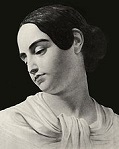
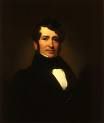
On May 16, 1836 after booze gets him expelled from West Point in 1831 after 6 mo., Boston, Mass.-born 27-y.-o. Edgar Allan Poe (1809-49) marries his 13-y.-o. 1st cousin Virginia Eliza Clemm (1822-47), who dies of TB, launching his drunken downhill slide; he immortalizes her as Lenore. In July 1838 he pub. his first and only novel The Narrative of Arthur Gordon Pym of Nantucket. He did much better with short stories and poetry. In 1839 he pub. Tales of the Grotesque and Arabesque; incl. William Wilson, The Fall of the House of Usher; Roderick's sister Madeline is in a catatonic trance. In Apr. 1841 he pub. The Murders in the Rue Morgue in Graham's Mag., becoming the first detective (mysery) story; the sequel is The Mystery of Marie Roget. In 1842 George Pope Morris (1802-64) becomes ed. of the New York Evening Mirror (until 1846), which pub. stories by Edgar Allan Poe (1809-49), William Cullen Bryant (1794-1878) et al. In 1842 Poe pub. The Masque of the Red Death; The Pit and the Pendulum; "Down - still unceasingly still inevitably down!... I shrunk convulsively at its every sweep." In June 1843 he pub. The Gold Bug in Philly's Dollar Newspaper; William Legrand is bitten by a you know what and goes looking for Capt. Kidd's treasure on Sullivan's Island, S.C. with his superstitious black servant Jupiter, and finds all $14M of it using cryptography. In 1844 he pub. Marginalia (1844-9); "By ringing small changes on the words leg-of-mutton and turnip - changes so gradual as to escape detection - I would 'demonstrate' that a turnip was, is, and of right, ought to be a leg-of-mutton." On Jan. 29, 1845 Edgar Allan Poe's poem The Raven is pub. in the New York Evening Mirror, making him famous; "Once upon a midnight dreary,/ as I pondered weak and weary"; too bad, he stinks himself up by accusing Henry Wadsworth Longfellow of plagiarism, and showing up drunk for a public appearance in Boston. In 1846 he pub. The Cask of Amontillado. In 1847 he pub. Ulalume; a man takes a walk one night in "lonesome October", ending up at the vault of his "lost Ulalume" exactly 1 year after burying her. He dies on Oct. 7, 1849 in Baltimore, Md. after being found delirious from a drinking binge on Oct. 3, repeatedly calling the name "Reynods" (allergy, rabies, diabetes, murdered?); dies 10 days before a planned marriage with 2nd wife Sarah Elmira Royster Shelton, his boyhood sweetheart, atempting to accompany Mrs. Clemm to it; his cousin Neilson Poe doesn't announce his death publicly, and only 10 show up for his funeral; the train carrying his tombstone crashes; his lit. executor Rufus Griswold pub. a mean obituary that damages his rep for decades until he is rediscovered by Charles Baudelaire, Stephane Mellarme, and Paul Valery; he finally gets a proper funeral in 2009; last words: "The best thing a friend could do for me is blow my brains out... Lord help my poor soul"; his home at 85 W. 3rd St., New York City is later claimed to be haunted; beginning on Jan. 19, 1949, the Poe Toaster, a mysterious stranger dressed in black and wearing a fedora hat begins laying three roses and a half-filled bottle of cognac on Poe's grave marker in Baltimore for his birthday, and in 1977 Poe House curator Jeff Jerome begins holding a vigil for him; in 1993 he leaves a note saying "The torch will be passed"; in 2001 he leaves a note mentioning the NFL Baltimore Ravens; in 2007 former ad exec Sam Porpora (1915-) claims to be him.

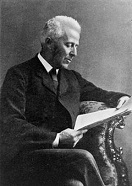

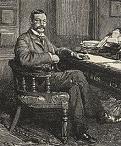
In 1887 Edinburgh, Scotland-born opthalmologist Sir Arthur Ignatius Conan (Gael. "high") Doyle (1859-1930) pub. A Study in Scarlet, which introduces Sherlock Holmes (based on Edinburgh surgeon Dr. Joseph Bell, and named for U.S. Supreme Court justice Oliver Wendell Holmes Jr. and cricket player Sherlock), who wears a deerstalker hat and an Inverness cape, lives at 221B Baker St. in London, has a trusty sidekick named Dr. John H. Watson (who marries his 2nd wife Mary Morstan on May 1, 1889 in Camberwell), plays a 500-guinea Stradivarius violin, likes 7% solution cocaine and morphine, uses the alias Stanley Sigurdson, and applies techniques from the emerging science of forensics to solve the most intractable crimes; Doyle receives £25 for it; Holmes is modeled on Scottish forensic surgeon Joseph Bell (1837-1911); the first person to play Holmes on stage is Charles Hallam Elton Brookfield (1857-1913). In 1890 he pub. The Sign of Four; also The Firm of Girdlestone. In Jan. 1891 The Strand Magazine begins pub., with initial circ. of 300K, based in Burleigh St. off The Strand, London, ceasing pub. in Mar. 1950; first ed. (1891-1930) is Herbert Greenhough Smith (1855-1935), who goes on to pub. many Arthur Conan Doyle Sherlock Holmes stories and boost his career. In 1891 Doyle pub. The Adventures of Sherlock Holmes; in the new The Strand Mag. beginning in the July issue and ending in 1927 after 56 stories; "I play the game for the game's own sake" (Holmes); Holmes and his nemesis Prof. James Moriarty fall to their deaths in May 1891 in Reichenbach Falls in the Dec. 1893 issue, and the public outcry, bordering on nat. mourning forces a reappearance eight years later in A Scandal in Bohemia, which begins with the line "To Sherlock Holmes she is always THE woman" (Irene Adler); the 1893 story The Gloria Scott contains the phrase "the chaplain stood with a smoking pistol in his hand", coining the term "smoking gun". In 1901 he pub. The Final Problem; Sherlock Holmes and his archenemy Prof. Moriarty plunge to their deaths from Reichenbach Falls; a barrage from fans causes Doyle to relent and bring Holmes back in the 1903 story The Adventure of the Empty House, later collected in the book The Return of Sherlock Holmes. In 1902 he pub. The Hound of the Baskervilles; a bloodhound-mastiff cross. In 1912 he pub. The Lost World; an expediton to the Monte Roraima (Tepuyes) Plateau in Venezuela and Guyana by Prof. Challenger, Lord John Roxton, and journalist Ed Malone finds living dinos, early human hominids, and vicious ape-like creatures - this jararaca's on you? His creation of the super-rational Sherlock Holmes combined with his own irrational belief in Spiritualism is proof that Geminis have a dual nature?

In 1904 Kensington, London-born Gilbert Keith "G.K." Chesterton (1874-1936) ("the Prince of Paradox") pub. The Napoleon of Notting Hill; set in 1984 London, when the govt. doesn't care. In 1905 he pub. The Club of Queer Trades (short stories). In 1908 he pub. The Man Who Was Thursday: A Nightmare; about anarchists and spies, with a Roman Catholic moral; inspires Michael Collins with the idea that "If you didn't seem to be hiding nobody hunted you out." In 1909 he pub. The Club of Queer Trades (short stories); also The Ball and the Cross. In 1911 he pub. The Innocence of Father Brown, introducing amateur detective Father Brown, who is featured in 53 short stories pub. in 1910-36, based on Bradford, Yorkshire parish priest John Monsignor O'Connor (1870-1952), who helps him convert from Anglicanism to Roman Catholicism in 1922; first of a series; "The miracle book of 1911" - Saturday Evening Post. In 1914 he pub. The Flying Inn; the Ottoman Empire conquers Britain and imposes Sharia. In 1935 he pub. The Scandal of Father Brown.
 I
IIn 1906 Allegheny City (Pittsburgh), Penn.-born "American Agatha Christie" Mary Roberts Rinehart (nee Mary Ella Roberts) (1876-1958) pub. her first novel The Man in Lower Ten. In 1908 she pub. The Circular Staircase; her first bestseller; the first "had-I-but-known" novel; "A middle-aged spinster is persuaded by her niece and nephew to rent a country house for the summer, which turns out to belong to a banker who has hidden stolen securities in the walls." In 1930 she pub. The Door, which allegedly coins the cliched phrase "the butler did it".

In 1910 London-born Alan Alexander "A.A." Milne (1882-1956) pub. The Day's Play. In 1917 he pub. Once on a Time. In 1920 he pub. Mr. Pym Passes By. In 1922 he pub. The Red House Mystery; first mystery to use light humor as an important feature? On Oct. 14, 1926 he pub. Winnie-the-Pooh in London; original name Edward Bear; friends incl. Piglet, Eeyore (whose tail Christopher Robin reattached with a nail), Owl, Rabbit, Kanga and her son Roo; written for his son Christopher Robin Milne (1920-96); the book's success causes the name "Christopher" (Gr. "bearer or carrier of Christ") to become popular by the 1940s; "What's for breakfast?"; "'We'll be Friends Forever, won't we, Pooh?' asked Piglet. 'Even longer', Pooh answered"; "PLES RING IF AN RNSER IS REQUIRD" (Owl's tree-house door). In 1927 he pub. Now We Are Six. In 1928 he pub. The House at Pooh Corner. In 1931 he pub. Two People.


In 1920 Torquay, Devon-born Agatha Christie (Agatha Mary Clarissa Christie, Lady Mallowan) (nee Miller) (1890-1976) pub. her first novel The Mysterious Affair at Styles, which introduces 5'4" Belgian detective Hercule Poirot, who retired from the Belgian police dept. in 1904, and relies on his "leetle gray cells" to solve crimes; also introduces Chief Inspector Japp and Captain Hastings; first of 80 novels and short story collections incl. 38 Hercule Poirot, 12 Miss Jane Marple, and five Thomas "Tommy" Beresford and Prudence "Tuppence" Cowley books, plus six under the alias Mary Westmacott, and 19 plays; praised by the Pharmaceutical Journal "for dealing with poisons in a knowledgeable way, and not with the nonsense about untraceable substances that so often happens." In 1922 she pub. The Secret Adversary; introduces Thomas "Tommy" Tuppence and Prudence "Tuppence" Cowley, who start out as blackmailers but find out that being detectives is more profitable. In 1923 she pub. The Murder on the Links; Hercule Poirot #2. In 1924 she pub. Poirot Investigates (short stories) (Mar.); Hercule Poirot #3; The Man in the Brown Suit (Aug.); Anne Beddingfeld and Col. Race in South Africa. In 1925 she pub. The Secret of Chimneys (June); Supt. Battle and Lady Eileen "Bundle" Brent. In 1927 she pub. The Big Four (Jan. 27) (short stories); Hercule Poirot #5; Hercule gets twin brother Achille Poirot; Countess Vera Rossakoff. In 1928 she pub. The Mystery of the Blue Train (Mar. 29); Hercule Poirot #6. In 1929 she pub. The Seven Dials Mystery (Jan. 24); Lady Eileen Brent, Lord Caterham, Bill Eversleigh, George Lomax, and Supt. Battle; also Partners in Crimes (short stories) (Sept. 16); Tommy and Tuppence Beresford #2. In 1930 she pub. The Mysterious Mr. Quin (short stories) (Apr. 14); Giant's Bread (Apr.); pub. under alias Mary Westmacott (#1); The Murder at the Vicarage (Oct.); who killed odious Col. Protheroe?; introduces Harris Tweed-loving elderly spinster amateur sleuth Miss Jane Marple, who lives in the village of St. Mary Mead and whose small maid is named Gwen; her nephew Raymond West is a writer; the first appearance of Miss Marple was in the Dec. 1927 short story "The Tuesday Night Club", which later becomes chap. 1 of "The Thirteen Problems" (1932); also introduces vicar Leonard Clement and his wife Griselda. On Sept. 7, 1931 she pub. The Sittaford Mystery (The Murder at Hazlemoore). In Feb. 1932 she pub. Peril at End House; Hercule Poirot #7; The Thirteen Problems (The Tuesday Club Murders) (June); Miss Marple #2; it was arsenic. In Sept. 1933 she pub. Lord Edgware Dies (Thirteen at Dinner); Hercule Poirot #8; The Hound of Death and Other Stories (Oct.); incl. The Witness for the Prosecution. On Jan. 1, 1934 she pub. Murder on the Orient Express; Hercule Poirot #9; her best work?; title changed to "Murder on the Stamboul Train" in the U.S. to avoid confusion with Graham Greene's 1932 novel "Orient Express"; inspired by a 1929 ride she took on the Orient Express, when it got caught in a snowbank, and written in the Hotel Pera Palace in Istanbul; 13 passengers, all suspected of killing the 14th, rich Mr. Ratchett, a notorious kidnapper and child murderer, and all having alibis from others who couldn't have been accomplices, with no mutual alibis, after which Hercule Poirot uncovers the most improbable solution, that they all conspired together to do it, which because Ratchett is such a rat he keeps to himself, along with a 2nd one of a lone killer who jumped the train, which he gives to the police after the train is unstuck; really an execution complete with a judge and 12-man jury?; a channeling of the JFK assassination, with the govt. judging and executing its chief executive, and producing the Lone Gunman Theory? also Unfinished Portrait (Mar.); pub. under the alias Mary Westmacott (#2); also Murder in Three Acts; also The Listerdale Mystery (short stories) (June); incl. Philomel Cottage; also Why Didn't They Ask Evans? (The Boomerang Clue) (Sept.); also Parker Pyne Investigates (Mr. Parker Pyne, Detective) (Nov.); detective Christopher Parker Pyne; introduces Ariadne Oliver and Miss Felicity Lemon; also Three Act Tragedy (Murder in Three Acts) (Hercule Poirot #10); Mr. Satterthwaite. On Mar. 10, 1935 she pub. Death in the Clouds (Air). On Jan. 6, 1936 she pub. The A.B.C. Murders; Hercule Poirot #11; also Murder in Mesopotamia (July 6); Hercule Poirot #12; also Cards on the Table (Nov. 2); Hercule Poirot #13; introduces Ariadne Oliver. On Mar. 15, 1937 she pub. Murder in the Mews and Other Stories (Dead Man's Mirror); Hercule Poirot #14; also Dumb Witness (Poirot Loses a Client) (July 5); also Hercule Poirot #15; also Death on the Nile (Nov. 1); Hercule Poirot #16. On May 2, 1938 she pub. Appointment with Death; Hercule Poirot #17; also Hercule Poirot's Christmas (Murder for Christmas) (A Holiday for Murder) (Dec. 19); Hercule Poirot #18. On June 5, 1939 she pub. Murder is Easy (Easy to Kill); Supt. Battle; also The Regatta Mystery and Other Stories; Hercule Poirot, Miss Marple, Parker Pyne; also And Then There Were None (Ten Little Niggers) (Nov. 6); her masterpiece?; big hit about 10 strangers who arrive at an isolated location and then mysteriously die one by one; filmed in 1945, 1965, 1974, 1987, 1989, and 2003 (as "Identity"). In Mar. 1940 she pub. Sad Cypress; Hercule Poirot #19; first Poirot courtroom drama; also One, Two, Buckle My Shoe (The Patriotic Murders) (An Overdose of Death) (Nov.); Hercule Poirot #20. In June 1941 she pub. Evil Under the Sun; Hercule Poirot #21. In Feb. 1942 she pub. The Body in the Library; Miss Marple; Five Little Pigs (Murder in Retrospect) (May); Hercule Poirot #22; The Moving Finger (July); Miss Marple. In June 1943 she pub. Towards Zero; last with Supt. Battle; also Absent in the Spring (Aug.); pub. under alias Mary Westmacott (#3); title from Shakespeare's Sonnet 98; also Death Comes at the End (Oct.); set in Thebes in 2000 B.C.E. In Feb. 1944 she pub. Sparkling Cyanide (Remembered Death); Col. Race. In 1946 she pub. The Hollow (Murder After Hours) (Nov.); Hercule Poirot #23; she later claims she ruined the novel by putting Poirot in it. In Sept. 1947 she pub. The Labours of Hercules; Hercule Poirot #24; he decides to end his career with 12 last cases. In Mar. 1948 she pub. Taken at the Flood (There is a Tide...); Hercule Poirot #25; also The Witness for the Prosecution and Other Stories; also The Rose and the Yew Tree (Nov.); pub. under alias Mary Westmacott (#4); title taken from "Four Quartets" by T.S. Eliot: "The moment of the rose and the moment of the yew-tree/ Are of equal duration." In Mar. 1949 she pub. Crooked House; her personal favorite along with "Ordeal by Innocence" (1958). In 1950 she pub. Three Blind Mice and Other Stories; A Murder is Announced (June); Miss Marple. On Mar. 5, 1951 she pub. They Came to Baghdad; also The Under Dog and Other Stories. In Feb. 1952 she pub. Mrs. McGinty's Dead; Hercule Poirot #26; Ariadne Olivier begins to be a major player; also They Do It With Mirrors (Murder with Mirrors) (Nov. 17); Miss Marple; also A Daughter's Daughter (Nov. 24); pub. under alias Mary Westmacott (#5). In Mar. 1953 she pub. After the Funeral (Funerals Are Fatal); Hercule Poirot #27; A Pocket Full of Rye (Nov. 9); Miss Marple.

On Feb. 1, 1929 St. Mary's County, Md.-born Dashiell Hammett (1894-1961) pub. his first novel Red Harvest, narrated by the Continental Op, who investigates the murder in Personville (Poisonville) of newspaper publisher Donald Willsson, whose industrialist father Elihu Willsson pays his Continental Detective Agency $10K to clean up the city of gangs; He follows on July 19, 1929 with The Dain Curse; firt pub. in Black Mask mag. in 1928-9; the Continental Op investigates the theft of diamonds from the Leggett family of San Francisco, Calif., leading to Edgar Leggett's wife Alice Dain, whose family has a curse of sudden violent death upon those in their vicinity, and to his daughter Gabrielle, who is involved in a mysterious religious cult that addicted her to morphine. On Feb. 14, 1930 he pub. The Maltese Falcon, written in a couple of days in San Francisco, where he lived since 1921; filmed in 1931 and 1941; "Sam Spade's jaw was long and bony, his chin a jutting V under the more flexible V of his mouth" (first line); Burritt Alley, where Miles Archer is murdered is one block away from Monroe St., one of the 8-10 places he lived; on Dec. 6, 1994 the Maltese Falcon statue is auctioned for $398,590; on Nov. 25, 2013 it is auctioned to Las Vegas hotel magnate Steve Wynn for $4.1M. On Apr. 24, 1931 he pub. The Glass Key; filmed in 1935 and 1942; his favorite?; in 1992 the Glass Key Award is established for best crime novel by a Scandinavian writer. In Dec. 1933 he pub. The Thin Man in Redbook; the last of his five novels; ex-detective Nick Charles and his wealthy admiring socialite wife Nora Charles, owners of female Schnauzer Astra are drawn into the case of inventor Clyde Miller Wynant; filmed in 1934-47 as a 6-part series starring William Powell and Myrna Loy, and an NBC-TV series in 1957-9 starring Peter Lawford and Phyllis Kirk.

In 1929 Inverness, Scotland-born Josephine Tey (Elizbeth MacKintosh) (1896-1952) pub. The Man in the Queue (Killer in the Crowd) under the alias Gordon Daviot, becoming #1 in the Inspector Alan Grant series (1929-52). In 1936 she follows with A Shilling for Candles (Inspector Alan Grant #2), filmed in 1937 by Alfred Hitchcock as "Young and Innocent". In 1948 she pub. The Franchise Affair (Inspector Alan Grant #3), about a a mother and daughter accused of kidnapping a young local woman; filmed in 1950 starring Michael Denison and Dulcie Gray. In 1950 she pub. To Love and Be Wise (Inspector Allen Grant #4). In 1951 she pub. The Daughter of Time (Inspector Alan Grant #5), with title from the proverb "Truth is the daughter of time"; Grant is confined to a hospital bed with a broken leg, and uses the time to solve the historical mystery of who killed the princes in the Tower, clearing Richard III; greatest crime mystery novel ever published? In 1952 she pub. The Singing Sands (Inspector Alan Grant #6) (last), based on the legend of Iram of the Pillars.

On Feb. 19, 1934 Annapolis, Md.-born James Mallahan Cain (1892-1977) pub. his first novel The Postman Always Rings Twice; filmed in 1946; "The reigning hot taboo novel before 'Forever Amber'" (Tom Wolfe). In 1936 he pub. Double Indemnity; serialized in Liberty Mag. in Feb.-Mar.; filmed in 1944. In 1937 he pub. Serenade. In 1941 he pub. Mildred Pierce, in which a struggling divorced Glendale, Calif. woman starts a chicken and waffle restaurant while juggling boyfriends and her wayward daughter Vedo; filmed in 1945. In 1942 he pub. Love's Lovely Counterfeit. In 1943 he pub. Three of a Kind. In 1947 he pub. The Butterfly. In 1948 he pub. Sinful Woman; also The Moth. In 1950 he pub. Jealous Woman. In 1953 he pub. Galatea. In 1954 he pub. The Root of His Evil. In 1962 he pub. Mignon (first novel since 1954). In 1965 he pub. The Magician's Wife; Clay Lockwood falls for a murderous woman.

In 1939 51-y.-o. Chicago, Ill.-born former oil exec Raymond Thornton Chandler (1888-1959) (known for liking women to commit murder in his novels) pub. his first novel The Big Sleep, about detective Philip Marlowe and "sleeping the big sleep", becoming a hit, defining the hardboiled detective novel style; filmed in 1946 and 1978. In 1940 he pub. Farewell, My Lovely. In 1942 he pub. The High Window. In 1943 he pub. The Lady in the Lake. In 1949 he pub. The Little Sister. In 1953 he pub. his 6th novel The Long Goodbye; "The first time I laid eyes on Terry Lennox he was drunk in a Rolls-Royce Silver Wraith outside the terrace of The Dancers"; written during the long terminal illness of his 18-year-older wife Cissy Chandler (1870-1954), after which he goes back to drinking and attempted suicide, and his career tanks.

In 1939 London-born James Hadley Chase (Rene Lodge Brabazon Raymond) (1906-85) (AKA James L. Doherty, Ambrose Grant, Raymond Marshall) gets turned on by James M. Cain's "The Postman Always Rings Twice" (1934) and pounds out his own novel based on the Barker Gang, portraying Ma Barker as the sinister gang leader, even though he never set foot in the U.S.; becomes a big hit, launching the gangster novel along with his career; turned into a stage play in 1942 at the Prince of Wales Theatre in London, starring Robert Newton (200+ perf.); filmed in 1948 - the FBI bought a bunch of copies?

In 1981 after years of being homless and compiling a criminal record, and almost dying of double pneumonia in 1977, Alcoholics Anonymous member Los Angeles, Calif.-born Lee Earle "James" Ellroy (1948-) pub. his first novel Brown's Requiem, about mysterious caddie Fat Dog Baker, who hires LA-based detective Fritz Brown to spy on his sister Jane and her sugar daddy Sol Kupferman, ending up attending a crooked golf tournament. In Sept. 1987 he pub. The Black Dahlia; the case of Elizabeth Short (1924-47), introducing postmodern historiographic metafiction; first in the L.A. Quartet ("The Big Nowhere", 1988; "L.A. Confidential", 1990; "White Jazz", 1992). In June 1990 he pub. L.A. Confidential; Edmund Exley, Wendell "Bud" White, and Jack Vincennes, a tight-knit group of LAPD officers in the early 1950s investigate a mass murder at the Nite Owl Coffee Shop and get tangled in a web of corruption fueled by scandal mag. "Hush-Hush"; #3 in the L.A. Quartet; filmed in 1997. His relentlessly pessimistic world view earns him the nickname "Demon dog of American crime fiction";